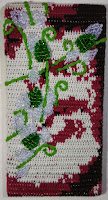Self-Talk: Bipolar
Each individual panel represents an internal thought, feeling, or manifestation of manic self-talk. Primary colors in fall hues convey the extremes of the season and weather like the turbulent changes of moods and mindsets of manic episodes. A sweeping gust of wind in secondary colors stands for the actions resulting from manic self-talk. 92 beaded crystal leaves blow across the piece representing the estimated 9,268,074 people in the U.S.A. who have bipolar disorder. Of those 92 leaves, 18 leaves are green representing the estimated 19.2% of adults with bipolar disorder who actually receive care.
Self-talk is something we do naturally. It is that little voice in the head that is almost never quiet; our internal narrator. Sometimes this voice is positive and sometimes not. When a person is bipolar and experiencing a manic episode, this self-talk becomes extreme and can cause symptoms to become even more intense. The positive/negative swings turn into a raging cycle of defeating actions. Bipolar disorder sufferers may end up with exhausting emotional flip-flops that can have devastating consequences.
$3800.00
Technique-
Half double tapestry crochet 5.5 mm, acrylic and velvet yarns wrap around stretched over 10 inch by 20 inch canvas. Brick stitch beaded 8mm plastic faceted crystal beads with 100% cotton thread, ribbon embroidery with acrylic yarn.
84cm x 180cm x 3cm
33in x 71in x 1.25in
(2.75ft x 5.9ft)
Data sourced from the National Institute of Mental Health









